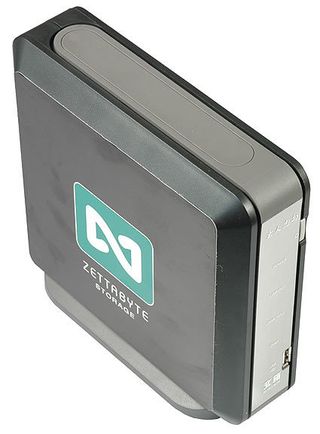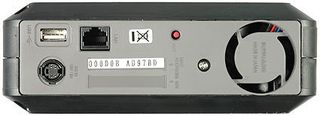Is Zettabits Next Generation Storage?
Zettabits

The Zettabits standard edition is available in capacities of 30 GB to 690 GB. Capacities do not match the available hard drive capacities (80, 120, 160, 200, 250, 320, 400, 500, 750 GB) because the device needs some room to hold Zettabyte's software. Obviously, 750 GB hard drives are the maximum Zettabyte is currently using. We received the 65 GB capacity version for testing.
The zBox of the Zettabits standard edition consists of a single 3.5" hard drive inside a plastic enclosure. A small and quiet 40 mm fan ensures proper ventilation. Dimensions of 6 x 18 x 18 cm are rather normal for a single drive storage device, but the look and feel of the product could be much better, because it reminds you of a low-cost solution, which in fact it isn't: the device is powered by a 266 MHz PowerPC processor and has 128 MB RAM. Zettabyte states a maximum power consumption of 18 W, which equals to our measurements; the idle power requirement is approximately 13 W.
There are two USB ports, but they aren't used at this time. The Zettabits Pro requires a USB port to attach the memory stick holding the decryption key, but it might be possible to use it for other applications such as local snapshot backups or similar. Capacity expansion could be another possible application, but I'm not sure how this would fit into the business model. The USB ports are not meant to be used for connecting the zBox to a host PC. Zettabits is a NAS-only solution at this time.
Setting rather high levels for security was important to Zettabyte; the device can only be administered via HTTPS, and Zettabyte does not use default passwords. Instead, the factory-set passwords are rather secure right from the start, as they consist of 12 randomly selected characters. You will find the password on the first page of the manual. All zBoxes automatically search for software updates; this is done in the background. During our testing, we noticed that the firmware version had changed from 1.4.4 to 1.4.6. You can go to the "what's new" section in the web setup and read about the update.
The zBox behaves like any other NAS device: you have to log on to its SSL web interface to configure it. At this point, it doesn't support user groups, only individual users. You can configure shares and access them via the device's IP address, which it can obtain from a DHCP server in your network, or you can set manually. Alternately, you can use the NetBIOS name, which is "zBox" by default, but can of course be changed.
You can access data on the zBox locally according to the permissions you defined on the shares. Although you can access all files, one tedious drawback is that you can only access one file at a time. Since all data is automatically mirrored to the Zettabits service, the second option of accessing your data is online, via the Zettabyte web interface. This is done by extracting the 256 bit AES key from the local zBox, which it uses to synchronize data online. You can only access the online storage using the encryption key, because no user login and password information is being transferred to the online location. As a consequence, users who get their hands on the key will be able to access all storage data independent from the permissions you defined for the zBox. Be very careful with this key! Zettabyte recommends that you store it on a USB Flash memory stick, and certainly not email it or store it in a publicly accessible location.



Stay on the Cutting Edge
Join the experts who read Tom's Hardware for the inside track on enthusiast PC tech news — and have for over 25 years. We'll send breaking news and in-depth reviews of CPUs, GPUs, AI, maker hardware and more straight to your inbox.
Most Popular

